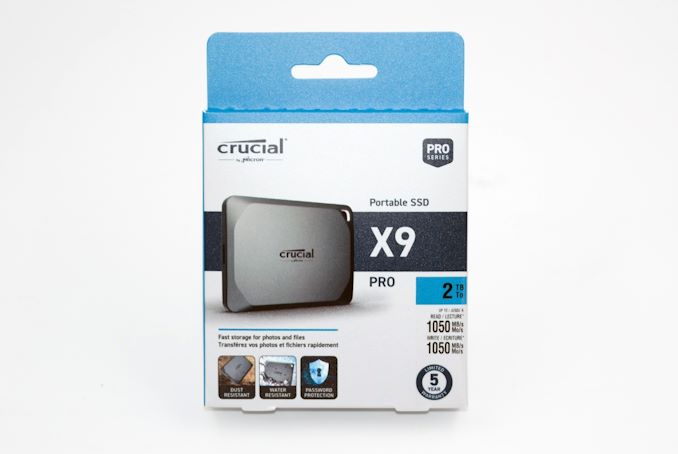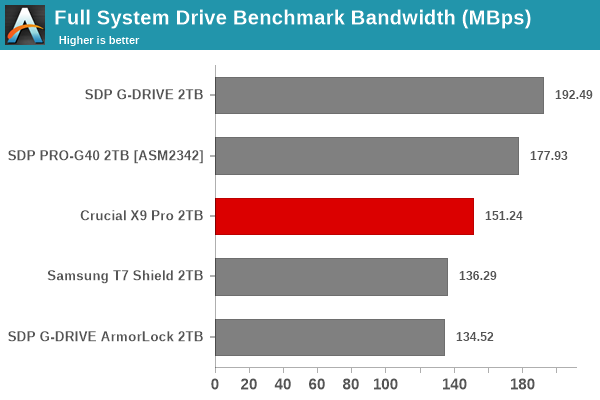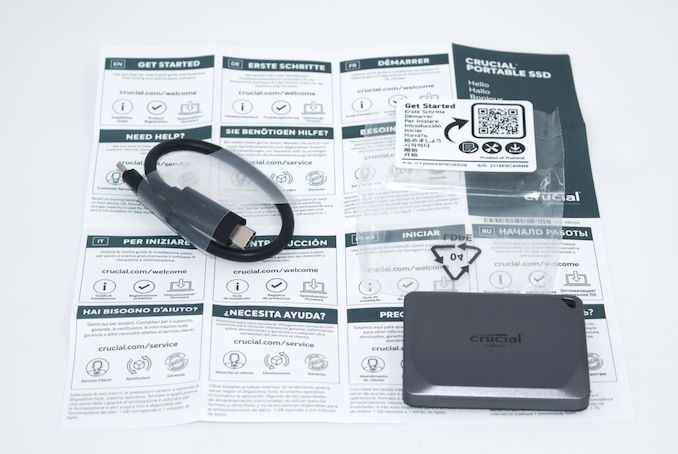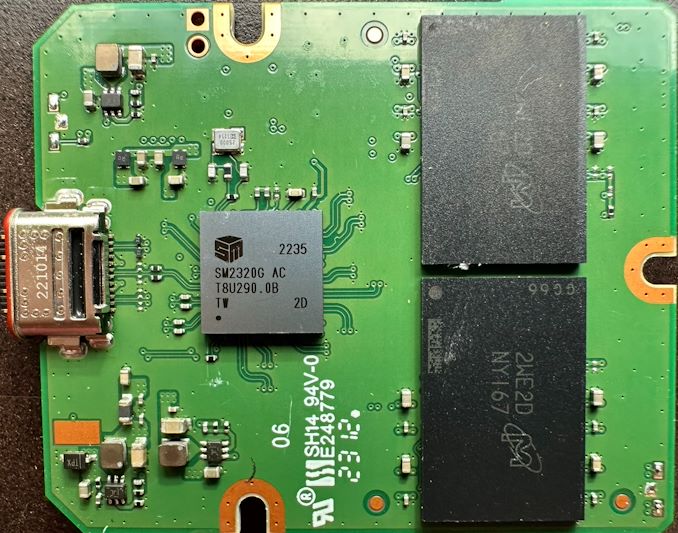
Original Link: https://www.anandtech.com/show/18987/crucial-x9-pro-portable-ssd-review-micron-176l-3d-nand-delivers-record-ufd-consistency
Crucial X9 Pro Portable SSD Review: Micron 176L 3D NAND Delivers Record UFD Consistency
by Ganesh T S on August 18, 2023 8:00 AM EST- Posted in
- Storage
- Crucial
- Micron
- DAS
- Silicon Motion
- Type-C
- USB
- Portable SSDs

Crucial's flash-based storage lineup has had a distinctive focus on internal SSDs, with a range of options catering to both mainstream and power users. On the portable SSD front, the company's X6 and X8 Portable SSDs have been attractive budget options for the mainstream consumers. However, these drives use QLC and are not entirely suitable for power users (such as content creators) who require writing vast amounts of data as quickly as possible.
The company introduced two new products in the PSSD category in July 2023 - the USB 3.2 Gen 2 X9 Pro, and the USB 3.2 Gen 2x2 X10 Pro. These 1 GBps and 2 GBps-class drives come with a Type-C port and a Type-C to Type-C cable (Type-A adapter sold separately). The performance specifications of these two products indicate suitability for power users - for the first time, the company is quoting write speeds for their PSSDs in the marketing material.
Crucial sampled the 2TB version of the X9 Pro for review, and we put it through our rigorous direct-attached test suite. This review takes a detailed look at the performance and value proposition of the PSSD, with a particular focus on how it stacks up against the existing players in the segment.
Introduction and Product Impressions
Flash technology has seen rapid advancements in recent years (such as the development of 3D NAND and improvements in TLC reliability). These have been accompanied by the appearance of faster host interfaces for external devices. Together, they have contributed to bus-powered direct-attached storage devices growing in both storage capacity and speeds. The Type-C standard has also achieved widespread acceptance in the consumer market. Protocols such as USB 3.2 Gen 2x2 / USB4 and Thunderbolt riding on top of the Type-C connector have enabled the introduction of palm-sized flash-based storage devices capable of delivering 2GBps+ speeds. The 10 Gbps USB 3.2 Gen 2 interface has become ubiquitous in moder systems and has emerged as the sweet spot for mainstream users.
One of the primary challenges with high-speed storage devices is the thermal aspect. Bridge-based solutions with multiple protocol conversion chips tend to dissipate more power due to the additional components. High-performance portable SSDs in the past have had no option but to use them - first, with SATA bridges, and then with NVMe bridges. The introduction of native UFD controllers capable of hitting 10 Gbps and 20 Gbps from Phison and Silicon Motion has opened up yet another option in this category. The Crucial X6, equipped with the Phison U17, was reviewed in August 2021 and was one of the first retail products to surpass the SATA speeds barrier by hitting 800 MBps speeds without using a NVMe bridge. Around the same time, Silicon Motion's SM2320 powered the Kingston XS2000 to 20 Gbps speeds without a bridge in the middle.
Products based on Silicon Motion's SM2320 have gained a lot of consumer mindshare because they have typically been able to hit the interface speed limits for sequential accesses in both the 10 Gbps and 20 Gbps categories. However, consistency was an issue as the initial wave of products used Micron's 96L 3D TLC or BiCS 4 / BiCS 5 (up to 112L) 3D TLC NAND. The introduction of faster flash has since allowed portable SSDs (PSSDs) based on the native UFD controllers to hit higher speeds and maintain them even in direct-to-TLC scenarios.
The X9 Pro we are looking at in this review is a 38g 65mm x 50mm USB 3.2 Gen 2 PSSD made of anodized aluminum. It includes a lanyard hole (with the LED near the hole, rather than near the Type-C port) and a rubberized soft-touch base for protection against bumps. The sides are slightly recessed for better traction during handling. It is IP55 rated, and drop-proof up to 7.5'. The packaging is minimal - a short USB 3.2 Gen 2 Type-C to Type-C cable and a user guide in addition to the main unit.
The Silicon Motion SM2320 native controller and Micron's 176L 3D TLC NAND packages are seen in the board. Each package appears to have eight 1 Tbit dies.
CrystalDiskInfo provides a quick overview of the capabilities of the internal storage device. TRIM and NCQ are not seen in the features list, though we have seen those available in other PSSDs based on the Silicon Motion SM2320. Crucial indicated that TRIM support will be enabled in the next firmware update. We will see in the next section that native command queuing is active in the PSSD, and all S.M.A.R.T features such as temperature read outs worked well.
| Comparative Direct-Attached Storage Devices Configuration | ||
| Aspect | ||
| Downstream Port | Native Flash | 1x PCIe 3.0 x4 (M.2 NVMe) |
| Upstream Port | USB 3.2 Gen 2 Type-C (Female) | USB 3.2 Gen 2 Type-C (Male) |
| Bridge Chip | Silicon Motion SM2320 | ASMedia ASM2362? |
| Power | Bus Powered | Bus Powered |
| Use Case | 1GBps-class, sturdy palm-sized high-performance portable SSD with a Type-C interface | 1GBps-class, IP67-rated rugged portable SSD for on-the-go content capture workflows |
| Physical Dimensions | 65 mm x 50 mm x 10 mm | 95 mm x 50 mm x 15 mm |
| Weight | 38 grams | 91 grams |
| Cable | 22 cm USB 3.2 Gen 2 Type-C (male) to Type-C (male) | 49 cm USB 3.2 Gen 2 Type-C to Type-C 48 cm USB 3.2 Gen 2 Type-C to Type-A |
| S.M.A.R.T Passthrough | Yes | Yes |
| UASP Support | Yes | Yes |
| TRIM Passthrough | Yes | Yes |
| Hardware Encryption | Yes | Yes (256-bit AES, only via SanDisk Secure App) |
| Evaluated Storage | Micron B47R 176L 3D TLC | SanDisk BiCS 4 96L 3D TLC |
| Price | $130 | USD 360 |
| Review Link | Crucial X9 Pro 2TB Review | SanDisk Professional G-DRIVE SSD 2TB Review |
Prior to looking at the benchmark numbers, power consumption, and thermal solution effectiveness, a description of the testbed setup and evaluation methodology is provided.
Testbed Setup and Evaluation Methodology
Direct-attached storage devices (including thumb drives) are evaluated using the Quartz Canyon NUC (essentially, the Xeon / ECC version of the Ghost Canyon NUC) configured with 2x 16GB DDR4-2667 ECC SODIMMs and a PCIe 3.0 x4 NVMe SSD - the IM2P33E8 1TB from ADATA.
The most attractive aspect of the Quartz Canyon NUC is the presence of two PCIe slots (electrically, x16 and x4) for add-in cards. In the absence of a discrete GPU - for which there is no need in a DAS testbed - both slots are available. In fact, we also added a spare SanDisk Extreme PRO M.2 NVMe SSD to the CPU direct-attached M.2 22110 slot in the baseboard in order to avoid DMI bottlenecks when evaluating Thunderbolt 3 devices. This still allows for two add-in cards operating at x8 (x16 electrical) and x4 (x4 electrical). Since the Quartz Canyon NUC doesn't have a native USB 3.2 Gen 2x2 port, Silverstone's SST-ECU06 add-in card was installed in the x4 slot. All non-Thunderbolt devices are tested using the Type-C port enabled by the SST-ECU06.
The specifications of the testbed are summarized in the table below:
| The 2021 AnandTech DAS Testbed Configuration | |
| System | Intel Quartz Canyon NUC9vXQNX |
| CPU | Intel Xeon E-2286M |
| Memory | ADATA Industrial AD4B3200716G22 32 GB (2x 16GB) DDR4-3200 ECC @ 22-22-22-52 |
| OS Drive | ADATA Industrial IM2P33E8 NVMe 1TB |
| Secondary Drive | SanDisk Extreme PRO M.2 NVMe 3D SSD 1TB |
| Add-on Card | SilverStone Tek SST-ECU06 USB 3.2 Gen 2x2 Type-C Host |
| OS | Windows 10 Enterprise x64 (21H1) |
| Thanks to ADATA, Intel, and SilverStone Tek for the build components | |
The testbed hardware is only one segment of the evaluation. Over the last few years, the typical direct-attached storage workloads for memory cards have also evolved. High bit-rate 4K videos at 60fps have become quite common, and 8K videos are starting to make an appearance. Game install sizes have also grown steadily even in portable game consoles, thanks to high resolution textures and artwork. Keeping these in mind, our evaluation scheme for portable SSDs and UFDs involves multiple workloads which are described in detail in the corresponding sections.
- Synthetic workloads using CrystalDiskMark and ATTO
- Real-world access traces using PCMark 10's storage benchmark
- Custom robocopy workloads reflective of typical DAS usage
- Sequential write stress test
In the next couple of sections, we have an overview of the performance of the two PNY PSSDs in these benchmarks. Prior to providing concluding remarks, we have some observations on the drives' power consumption numbers and thermal solution also.
Performance Benchmarks
Benchmarks such as ATTO and CrystalDiskMark help provide a quick look at the performance of the direct-attached storage device. The results translate to the instantaneous performance numbers that consumers can expect for specific workloads, but do not account for changes in behavior when the unit is subject to long-term conditioning and/or thermal throttling. Yet another use of these synthetic benchmarks is the ability to gather information regarding support for specific storage device features that affect performance.
Crucial claims read and write speeds of up to 1050 MBps. The numbers obtained in the ATTO benchmarks below reach very close to that number. ATTO benchmarking is restricted to a single configuration in terms of queue depth, and is only representative of a small sub-set of real-world workloads. It is likely that Crucial's quoted numbers are for a different queue depth. ATTO does allow the visualization of change in transfer rates as the I/O size changes, with optimal performance being reached around 2048 KB for a queue depth of 4. Any transfer size upwards of 128 KB is enough to give the impression of a saturated interface for mainstream users, though.

The overall scores see the Crucial X9 Pro in the middle of the pack and that is a creditable result, given that all the other PSSDs are bridge-based high-performance ones.
Miscellaneous Aspects and Concluding Remarks
The performance of the Crucial X9 Pro 2 TB PSSD in various real-world access traces as well as synthetic workloads was brought out in the preceding sections. We also looked at the performance consistency for these cases. Power users may also be interested in performance consistency under worst-case conditions, as well as drive power consumption. The latter is also important when used with battery powered devices such as notebooks and smartphones. Pricing is also an important aspect. We analyze each of these in detail below.
Worst-Case Performance Consistency
Flash-based storage devices tend to slow down in unpredictable ways when subject to a large number of small-sized random writes. Many benchmarks use that scheme to pre-condition devices prior to the actual testing in order to get a worst-case representative number. Fortunately, such workloads are uncommon for direct-attached storage devices, where workloads are largely sequential in nature. Use of SLC caching as well as firmware caps to prevent overheating may cause drop in write speeds when a flash-based DAS device is subject to sustained sequential writes.
Our Sequential Writes Performance Consistency Test configures the device as a raw physical disk (after deleting configured volumes). A fio workload is set up to write sequential data to the raw drive with a block size of 128K and iodepth of 32 to cover 90% of the drive capacity. The internal temperature is recorded at either end of the workload, while the instantaneous write data rate and cumulative total write data amount are recorded at 1-second intervals.
| CrystalDiskMark Workloads - Power Consumption | |
| TOP: | BOTTOM: |
 |
|
 |
|
It is no surprise that the Crucial X9 Pro has the least averaged power consumption for the workload traces, given that it employs a single-chip (native UFD controller) solution compared to the dual-chip bridge-based solutions in the other PSSDs. The Crucial X9 Pro idles at lesser than 0.75 W and goes into a deep-sleep state with essentially 0W bus power consumption after around 20 minutes of inactivity. The peak power number is 4.17 W, but the power consumption with active traffic appears to be around 1.5 - 1.8 W. The bridge-based PSSDs operate at around 2.5 W - 3 W under similar conditions.
Final Words
The Crucial X9 Pro has been available in the market for a few weeks now, and the pricing has been stable since launch. The 2 TB version is priced at $130, which is par for the course. The SanDisk PSSDs presented as comparison units are more of a premium offering, priced upwards of $200 at that capacity point, but the Samsung T7 Shield at $120 provides stiff competition from a value perspective. Western Digital also has the WD My Passport SSD at $115 for the 2 TB version, but we do not have a sample at that capacity point to present a performance comparison. However, based on our evaluation of the SanDisk Professional G-DRIVE PSSD with a similar internal platform, the comparison from a performance perspective for DAS workloads is still between the T7 Shield and the X9 Pro. The main advantages of the Crucial X9 Pro over the Samsung T7 Shield lies in the power consumption numbers and the physical footprint of the device. The SanDisk drives enjoy better overall performance due to their bridge-based configuration, but recent firmware issues in their PSSD lineup make it difficult for us to recommend them at this moment. Irrespective of the PSSD used, consumers should adopt the 3-2-1 backup strategy to ensure data safety.
Compared to the Samsung T7 Shield, Crucial also bundles some value-adds like a free month of Adobe Creative Cloud All Apps and a free month of Mylio Photos+. While Samsung seems to have a similar Adobe promotion for its T7 customers, redemption seems to be a tricky issue.
Crucial still has a bit of work to do on the firmware and software front. The TRIM functionality is currently under QA prior to public release. This may affect power consumption spikes under idling conditions, but is unlikely to alter our conclusions about the power efficiency of the platform. Crucial has also promised to release a password-protection utility later this year to utilize the hardware encryption capabilities of the X9 Pro platform.
The Crucial X9 Pro has class-leading performance specifications, and the claimed numbers are backed up by our evaluation. There are certain scenarios where true top-tier SSD performance (such as high IOPS for random access scenarios) may be needed across a wide variety of use-cases. For such requirements, bridge-based PSSDs with a DRAM-equipped internal drive can perform better even within the 1 GBps-class interface limitations. However, for the vast majority of direct-attached storage use-cases, the performance profile, physical footprint, industrial design, and pricing of the Crucial X9 Pro represents an optimal combination.











